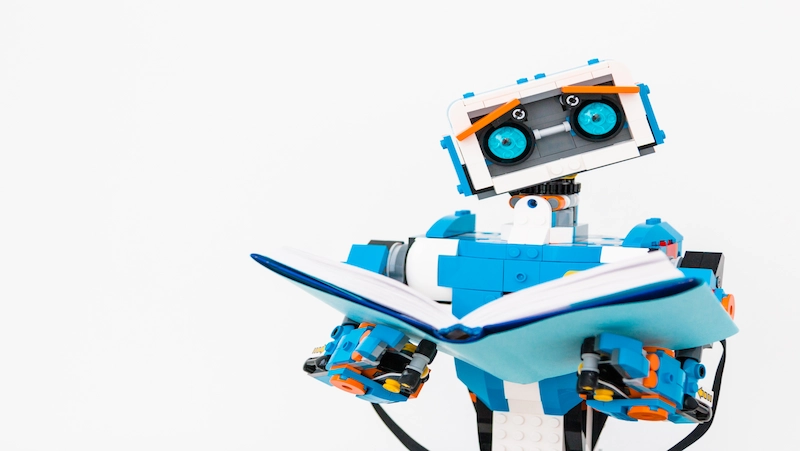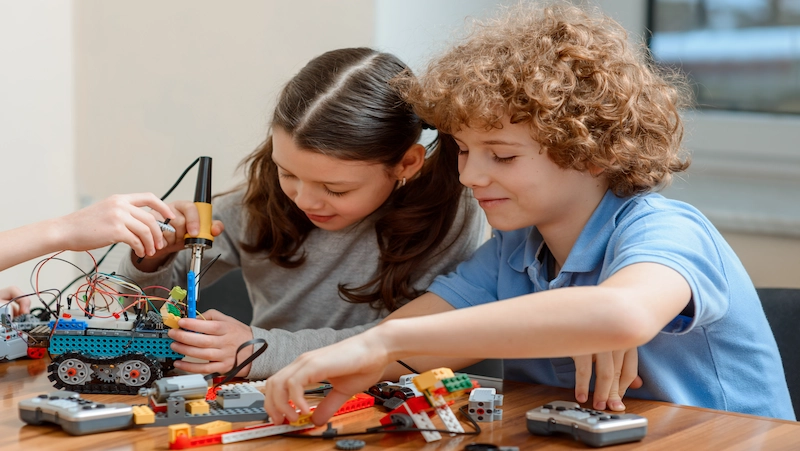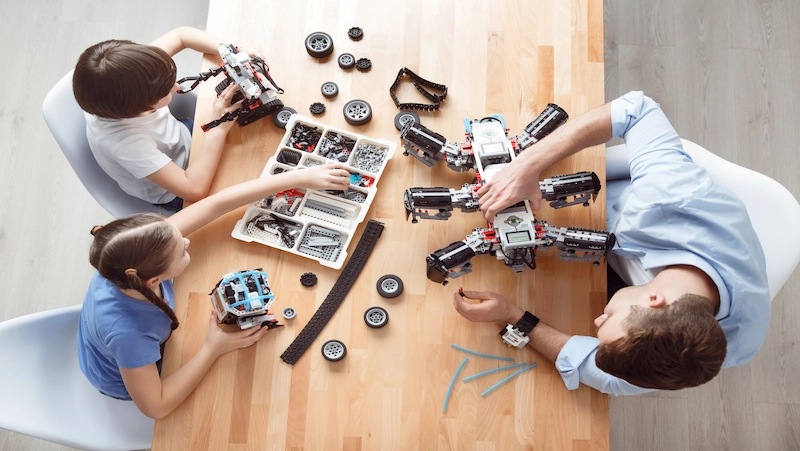In a world brimming with remarkable advancements, where technology shapes the very fabric of our lives, there is one field that stands out in its ability to captivate young minds and fuel their innate curiosity. Welcome to the realm of robotics—an extraordinary domain where imagination and innovation unite, igniting the potential of our children like never before.
Today, it is more crucial than ever to equip our young ones with the skills and knowledge that will empower them to navigate the complexities of tomorrow’s world. While traditional education remains invaluable, there is an exciting and transformative frontier that holds incredible promise: robotics education for kids.
From captivating robotic competitions to cutting-edge STEM (Science, Technology, Engineering, and Mathematics) programs, the rise of robotics has created a vast array of opportunities for young learners to engage, explore, and excel. In this blog, we delve into the profound importance of robotics for kids and unveil a world of benefits that await our future generation.
Join us on an awe-inspiring journey as we uncover everything parents should know about the transformative power of robotics. Brace yourselves, for we are about to witness how robotics unleashes the potential of young minds, preparing them to become the architects of our ever-evolving future.
Are you ready to embark on a path where technology meets creativity, and education takes a quantum leap into the realm of innovation? Then, let us dive headfirst into the captivating world of robotics and uncover the transformative potential it holds for our children.
Table of contents
Introduction to Robotics for Kids

You must be wondering what is robotics for kids, Robotics for Kids is a proven way to teach important 21st-century skills through practical robot building and coding. It generates curiosity in STEM subjects while providing an entertaining learning experience. By exploring concepts like artificial intelligence and robot mechanics, kids can gain a solid foundation in robotics and technology. At its core, robotics is the intersection of science, technology, and engineering that focuses on designing, building, and programming robots. A robot, in simple terms, is a machine that can perform tasks autonomously or under human control. These intelligent creations range from small, intricate devices to large, sophisticated systems, each designed with a specific purpose in mind.
Why Robotics for Kids is Important

As parents, we must know what is robotics for kids and why robotics is important for kids, Robotics for Kids is important because it offers a fun and engaging way to introduce children to advanced science, boosting their analytical thinking and problem-solving skills. Research shows that it has a positive impact on kids’ creativity and abilities, many parents, schools, and governments worldwide support robotics education at a young age. This enjoyable learning approach is loved by both children and adults, making it an effective tool for educational development.
Robotics education for kids has gained immense popularity in recent years, and for good reason. It offers a multitude of benefits that go beyond mere entertainment. By introducing children to robotics, we unlock a world of experiential learning, fostering essential skills that will shape their future success. Some of these benefits are:
Promoting STEM Skills: The world is evolving rapidly, and proficiency in STEM fields (Science, Technology, Engineering, and Mathematics) has become increasingly essential. Robotics introduces children to these disciplines in an engaging and hands-on manner, encouraging them to think critically, solve problems, and apply logical reasoning.
Developing Problem-Solving Abilities: Robotics presents children with real-world challenges that require analytical thinking and problem-solving skills. As they grapple with designing mechanisms, writing code, and troubleshooting, they develop resilience, perseverance, and the ability to approach complex problems with a systematic mindset.
Fostering Collaboration and Teamwork: Many robotics programs involve collaborative robotics projects for kids and competitions, fostering teamwork and communication skills. Children learn to work together, share ideas, delegate tasks, and appreciate the diverse perspectives that contribute to successful outcomes.
Building Confidence: As children accomplish tasks and witness their creations come to life, their confidence soars. Robotics provides a tangible platform for them to see the results of their efforts, encouraging a sense of achievement and boosting self-esteem.
Preparing for the Future: In a world increasingly influenced by automation and technology, robotics prepares children for the challenges and opportunities that lie ahead. By equipping them with a solid foundation in robotics, we empower them to navigate a technology-driven future with confidence and adaptability.
Different Types of Robotics Toys

And now its time to get ready to dive into the awesome world of robotics toys. You are about to go out on an exciting journey that combines creativity, learning, and fun! When it comes to introducing our children to the enchanting world of robotics, there is an astonishing array of captivating toys and kits that can ignite their imagination and foster their passion for technology. These innovative playthings not only entertain but also nurture essential skills like problem-solving, critical thinking, and creativity. In this section, we explore some of the different types of robotics toys that are available, each offering unique experiences and opportunities for young learners.
Construction Sets
Unleashing the power of imagination and engineering prowess, construction sets bring out the budding architect and engineer in our children. These sets often include interlocking building blocks or pieces that can be assembled to create robots with movable parts, offer a fantastic range of activities for kids. By following instructions or designing their unique creations, kids can learn about mechanical structures, spatial awareness, and problem-solving. Prominent construction sets like LEGO Boost and VEX IQ Robotics offer endless possibilities for building and designing robotic masterpieces.
Robotic Pets and Animals
For those seeking a touch of companionship and a glimpse into the world of biomimicry, robotic pets and animals are the perfect choice. These adorable robotic creatures respond to touch, interact with their surroundings, and sometimes even exhibit emotions. From robotic dogs that wag their tails and respond to voice commands to robotic dinosaurs that mimic realistic movements, these toys foster empathy, responsibility, and an appreciation for the wonders of the animal kingdom.
Coding Games and Puzzles
Combining the realms of robotics and gaming, coding games and puzzles for kids offer an interactive and entertaining way to introduce kids to programming concepts. These games often feature physical components like a game board or cards, accompanied by digital interfaces or apps that allow children to learn programming logic and solve challenges. By solving puzzles and completing missions, kids develop computational thinking skills and gain a solid foundation in coding principles.
Robotic Experiments and Kits
For young scientists and tinkerers, robotic experiment kits provide hands-on exploration and discovery, offering a wide array of games for kids to play. These kits typically include components like circuit boards, motors, sensors, and instruction manuals that guide children through various experiments and projects. From building a light-sensitive robot to constructing a line-following vehicle, these kits foster a deeper understanding of electronics, mechanics, and engineering concepts, encouraging kids to become inventors in their own right.
By embracing the diversity of robotics toys, parents can find the perfect match for their child’s interests and learning style. Whether they aspire to be future engineers, or programmers, or simply want to have fun while learning, these toys serve as gateways to a world where science, technology, and imagination blend seamlessly.
In the next section, we will explore the remarkable benefits that robotics toys offer, delving into how they shape children’s cognitive, social, and emotional development. So, let’s dive deeper into the transformative power of these incredible playthings and discover how they unlock the potential of our young learners.
How to Choose the Right Robotics Toy

In the ever-expanding universe of robotics toys, where innovation seems to know no bounds, choosing the right one for your child may feel like navigating an uncharted terrain. With countless options available, each promising to spark creativity and nurture technical skills, how do you make an informed decision? Fear not, for we are here to guide you through the process of choosing the perfect robotics toy for your little adventurer.
Consider Age-Appropriate Options
First and foremost, it’s vital to consider your child’s age and developmental stage. Robotics toys come in a wide range of complexity, from basic building blocks for preschoolers to more advanced kits for older children. Ensure that the toy you select aligns with your child’s abilities and interests, striking a balance between challenging and engaging.
Assess Educational Value
Look for robotics toys that offer Fun & educational activities for kids, going beyond mere entertainment. Seek out toys that integrate STEM principles (Science, Technology, Engineering, and Mathematics) into their design. These toys encourage critical thinking, problem-solving, and logical reasoning skills while exposing children to fundamental concepts of coding, engineering, and robotics.
Explore Versatility and Expandability
Consider robotics toys that offer versatility and expandability. Opt for toys that provide multiple modes of play, allowing children to explore various functionalities and experiment with different challenges. Additionally, seek out toys that offer expansion packs or accessories, enabling your child to grow and explore new concepts as their interest and skills develop.
Safety and Durability
Prioritize the safety and durability of the robotics toy while promoting positive thinking for kids. Ensure that the materials used are non-toxic and age-appropriate. Look for sturdy construction that can withstand the inevitable bumps and falls during play. Additionally, check for certifications and quality standards to ensure the toy meets the necessary safety guidelines.
Read Reviews and Seek Recommendations
Take advantage of the vast resources available online. Read reviews from other parents and educators who have experience with robotics toys. Seek recommendations from trusted sources, such as educational websites, forums, and toy experts. Learning from the experiences of others can provide valuable insights and help you make a well-informed decision.
Remember, choosing the right robotics toy for your child is an investment in their growth, development, and future. By considering factors such as age appropriateness, educational value, hands-on learning, versatility, safety, and recommendations, you can embark on a rewarding journey that ignites your child’s passion for robotics, fosters their skills, and propels them toward a future filled with boundless possibilities.
Getting Started with Robotics

Embarking on a robotics journey with your child can be an exciting and fulfilling endeavor. Whether your little one dreams of building a robot that can navigate mazes or wishes to create a mechanical arm capable of picking up objects, getting started with robotics opens up a world of wonder and discovery. In this section, we will guide you through the essential steps to begin this captivating adventure.
Embrace the Learning Mindset:
First and foremost, foster a learning mindset within your child. Robotics is not solely about building robots; it is an opportunity for them to develop problem-solving skills, enhance logical thinking, and cultivate creativity. Encourage them to embrace challenges, learn from failures, and approach robotics with an open and curious mind.
Start with Simple Concepts:
Begin your journey by introducing foundational concepts of robotics. Explore the basic components such as motors, sensors, and controllers. Understand how these elements work together to bring a robot to life. Engaging in hands-on activities, such as assembling simple robot kits or playing with programmable toys, can be an excellent way to lay the groundwork for future explorations.
Discover Programming:
Programming is the language that brings robots to life. As your child progresses, introduce them to programming languages suitable for their age and skill level. Block-based coding platforms like Scratch or Blockly are excellent starting points for young beginners. As they gain confidence, they can transition to text-based programming languages like Python or C++. Check out Codechamps, a coding program offered by Brightchamps that introduces your kids to the concepts of programming in a fun and engaging way.
Encourage Collaboration:
Robotics is not a solitary pursuit but a collaborative and social endeavor. Encourage your child to join robotics clubs, participate in competitions, or collaborate with other young enthusiasts. Working in teams fosters communication, teamwork, and an environment for sharing ideas, thus enhancing their overall learning experience. You can also explore robotics camps for kids since such programs foster collaboration through group activities and discussions.
Explore Online Resources:
The internet is a treasure trove of resources for budding roboticists. Explore online tutorials, forums, and educational websites that offer a wealth of information and project ideas. YouTube channels, such as STEM-focused creators or robotics enthusiasts, can provide step-by-step guidance, demonstrations, and inspiration for your child’s robotics journey.
RoboChamps by BrightChamps, is a thrilling and innovative program that pushes the boundaries of technological education. With RoboChamps, kids delve into the captivating world of robotics, learning and honing their skills in a hands-on, interactive environment. Through RoboChamps, young minds are empowered to unleash their potential, embrace challenges, and become the champions of tomorrow’s technological landscape.
Cultivate a Maker Mindset:
Encourage your child to embrace their inner “maker.” Provide them with materials such as lego robotics for kids blocks, cardboard, or recycled objects, and challenge them to build their own robot prototypes. Emphasize the importance of creativity, innovation, and resourcefulness in the process. Remember, robots can be created from everyday objects—it’s the imagination that matters.
Remember, the journey of robotics is as much about exploration and learning as it is about building robots. Embrace the process, celebrate small victories, and encourage your child’s passion for robotics. By nurturing their curiosity, providing them with the necessary tools, and fostering a supportive environment, you lay the groundwork for a lifelong love affair with robotics—an adventure that will equip them with the skills they need to shape the future.
Activities to Do with Robotics Toys

Are you ready for some amazing activities with your robotics toys? Let’s explore the exciting world of practical activities! Create a challenge for your robot and observe how well it navigates it.Prepare yourself to discover the limitless possibilities of robotics fun and unlock your creativity. So, be ready and let the adventure begin!
1. Build and Program Your Own Robot:
One of the most exciting aspects of robotics toys is the ability to design and construct your very own robot. Encourage your child to unleash their creativity by building robots using kits or individual components. From assembling the chassis to connecting motors and sensors, this hands-on experience fosters critical thinking, problem-solving skills, and an understanding of engineering principles. Once the robot is built, the real magic begins—programming! Introduce your child to coding languages like Scratch or Python, enabling them to bring their robot to life and command it to perform various tasks.
2. Solve Real-Life Challenges:
Robots have become an integral part of our daily lives, from automated vacuum cleaners to assistive devices for individuals with special needs. Encourage your child to identify real-life challenges and think creatively about how robots can solve them. Whether it’s designing a robot that helps with household chores or building a robotic arm to aid someone with limited mobility, this activity nurtures empathy, problem-solving, and inventiveness. Encourage your child to prototype their ideas and iterate on their designs to create meaningful solutions.
3. Host a Robot Fashion Show:
Let your child’s imagination run wild as they design and dress up their robots for a fashion extravaganza. Challenge them to create unique outfits, add accessories, and personalize their robots’ appearances. This activity encourages creativity, storytelling, and aesthetics. Take it a step further by asking your child to present their robot’s abilities and features in a mini-presentation. This will boost their communication skills and confidence as they showcase their creations.
4. Collaborate on a Robotics Project:
Engage your child in a collaborative robotics project that involves problem-solving and teamwork. Choose a complex task, such as designing a robot to navigate a maze or simulate a rescue mission. This activity promotes communication, cooperation, and project management skills. As they work together, children learn to leverage each other’s strengths, brainstorm ideas, and divide tasks effectively.
Conclusion
In a world driven by rapid technological advancements, nurturing our children’s curiosity and preparing them for the future has never been more crucial. As we’ve explored in this blog, robotics presents a golden opportunity for young minds to delve into the realms of science, technology, engineering, and mathematics (STEM) in an exciting and hands-on manner.
If you are looking for a way to introduce your kids to the amazing field of robotics, checkout Robochamps. RoboChamps is a transformative program designed to ignite the passion for robotics in children. With a focus on hands-on learning and creative exploration, RoboChamps provides an immersive experience that empowers young minds to become tomorrow’s innovators. Through engaging projects, interactive lessons, and expert guidance, children develop critical thinking, problem-solving skills, and a deep understanding of STEM concepts. Learn about robotics for kids also.
Frequently Asked Questions (FAQs)
Robotics for kids involves learning about and engaging with the field of robotics through hands-on activities, building and programming robots. It is important because it nurtures crucial skills like problem-solving, critical thinking, creativity, and teamwork, preparing children for the technology-driven future and encouraging them to become innovators and leaders.
The appropriate age for kids to start learning about robotics varies, but generally, children as young as 6 or 7 can begin exploring basic concepts using age-appropriate robotics kits. However, more complex concepts and advanced programming skills are typically suitable for older children, around 10 years and above.
Robotics provides hands-on experiences that challenge children to solve problems and think critically. Through building and programming robots, kids learn to analyze situations, break down problems into manageable parts, test solutions, and iterate based on feedback. This iterative process enhances their problem-solving abilities and fosters critical thinking skills.
Kids can build and program various types of robots, such as line-following robots, obstacle-avoiding robots, robotic arms, or even humanoid robots. These projects introduce children to different aspects of robotics, including movement, sensors, programming logic, and mechanical design.
Robotics competitions provide an exciting platform for kids to apply their robotics skills in a competitive environment. These competitions promote teamwork, communication, and strategic thinking. Additionally, they encourage creativity, inspire innovation, and offer opportunities for students to showcase their talents, build confidence, and network with like-minded individuals.
Absolutely! Robotics is a field open to everyone, regardless of gender. Girls can learn and excel in robotics just as much as boys. Encouraging girls to participate in robotics education and providing equal opportunities helps break gender stereotypes, fosters diversity, and promotes a more inclusive and innovative community.
Various programming languages are used in robotics for kids, including Scratch, Blockly, Python, Arduino, and LEGO Mindstorms programming languages. These languages cater to different skill levels and offer a progression from visual block-based programming to text-based coding, allowing kids to advance as they gain more experience.
There are several popular robotics kits for kids and tools available for kids, such as LEGO Mindstorms, VEX Robotics, Ozobot, Makeblock, and Sphero. These kits provide a range of components, sensors, and programming interfaces, allowing children to build and program robots with different functionalities and complexities.
Parents can encourage their kids to pursue robotics by providing access to robotics kits, enrolling them in robotics classes or workshops, and engaging in hands-on projects together. Encouraging experimentation, supporting their interests, and highlighting real-world applications of robotics can inspire children to view robotics as an exciting hobby or even a potential career path.
There are several excellent online resources for learning about robotics for kids, including websites like Robotics for Kids, Code.org, NASA Robotics Alliance, and STEM robotics platforms like Tinkercad and VEXcode VR. These resources offer tutorials, coding challenges, project ideas, and interactive simulations that make learning about robotics engaging and accessible.










